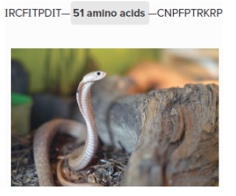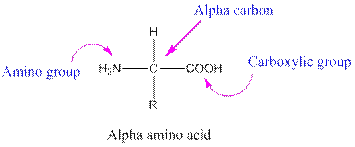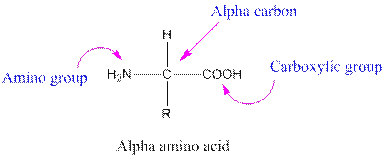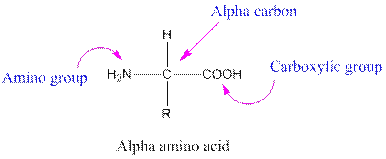
Concept explainers
a. How many amide bonds join the amino acids in the peptide chain?
b.Give the name of the N-terminal amino acid.
c.Give the name of the C-terminal amino acid. 
(a)
Interpretation:
The number of amide bonds that join the amino acids in the: IRCFITPDIT-51 amino acid-CNPFPTRKRP peptide chain.
Concept Introduction:
Amino acids are organic compounds containing two functional groups namely amino and carboxylic group. The amino group is attached to the alpha carbon, carbon adjacent to the carbonyl group making them alpha-amino acids.

Answer to Problem 38P
There are
Explanation of Solution
When amino acids joined to one another by amide bonds to form large molecules are called peptides. The amide bonds present in peptides are called peptides bonds.
To make a dipeptide, the amino group
To calculate the number of amide bonds present in any sequence will be one less the number of amino acids present in the sequence.
For example, there are two amino acids present in a dipeptide. Then, the number of amide bonds will be one.
The given sequence is as follows:
IRCFITPDIT-51 amino acid-CNPFPTRKRP
There are total
(b)
Interpretation:
The name of the N-terminal amino acid of the given amino acid sequence present in the bee venom should be determined.
IRCFITPDIT-51 amino acid-CNPFPTRKRP
Concept Introduction:
Amino acids are organic compounds containing two functional groups namely amino and carboxylic group. The amino group is attached to the alpha carbon, carbon adjacent to the carbonyl group making them alpha-amino acids.

Answer to Problem 38P
Isoleucine (I) will be the N-terminal amino acid present in the given sequence IRCFITPDIT-51amino acid-CNPFPTRKRP.
Explanation of Solution
Amino acid having a free
The name, one-letter and three-letter abbreviation of the amino acids are mentioned in the table given below:
| Name of Amino Acid | Three-letter abbreviation | One-letter abbreviation |
| Alanine | Ala | A |
| Asparagine | Asn | N |
| Cysteine | Cys | C |
| Glutamine | Gln | Q |
| Glycine | Gly | G |
| Isoleucine | Ile | I |
| Leucine | Leu | L |
| Methionine | Met | M |
| Phenylalanine | Phe | F |
| Proline | Pro | P |
| Serine | Ser | S |
| Threonine | Thr | T |
| Tryptophan | Trp | W |
| Tyrosine | Tyr | Y |
| Valine | Val | V |
| Aspartic acid | Asp | D |
| Glutamic acid | Glu | E |
| Arginine | Arg | R |
| Histidine | His | H |
| Lysine | Lys | K |
The given sequence is as follows:
IRCFITPDIT-51 amino acid-CNPFPTRKRP
From the table, 'I' will be the amino acid present at the N-terminal. And 'I' is the 'Isoleucine' amino acid.
(c)
Interpretation:
The name of the C-terminal amino acid of the given amino acid sequence present in the bee venom should be determined.
IRCFITPDIT-51 amino acid-CNPFPTRKRP
Concept Introduction:
Amino acids are organic compounds containing two functional groups namely amino and carboxylic group. The amino group is attached to the alpha carbon, carbon adjacent to the carbonyl group making them alpha-amino acids.

Answer to Problem 38P
Proline (P) will be the C-terminal amino acid present in the given sequence IRCFITPDIT-51amino acid-CNPFPTRKRP.
Explanation of Solution
Amino acid having a free
The name, one-letter and three-letter abbreviation of the amino acids are mentioned in the table given below:
| Name of Amino Acid | Three-letter abbreviation | One-letter abbreviation |
| Alanine | Ala | A |
| Asparagine | Asn | N |
| Cysteine | Cys | C |
| Glutamine | Gln | Q |
| Glycine | Gly | G |
| Isoleucine | Ile | I |
| Leucine | Leu | L |
| Methionine | Met | M |
| Phenylalanine | Phe | F |
| Proline | Pro | P |
| Serine | Ser | S |
| Threonine | Thr | T |
| Tryptophan | Trp | W |
| Tyrosine | Tyr | Y |
| Valine | Val | V |
| Aspartic acid | Asp | D |
| Glutamic acid | Glu | E |
| Arginine | Arg | R |
| Histidine | His | H |
| Lysine | Lys | K |
The given sequence is as follows:
IRCFITPDIT-51amino acid-CNPFPTRKRP
From the table, 'P' will be the amino acid present at the C-terminal. And 'P' is the 'Proline' amino acid.
Want to see more full solutions like this?
Chapter 21 Solutions
General, Organic, and Biological Chemistry - 4th edition
- Using both three- and one-letter codes for amino acids, write the structures of all possible peptides containing the following amino acids: (a) Val, Ser, Leu (b) Ser, Leu2, Proarrow_forwardConsider the tripeptide tyrosylleucylisoleucine. a. Specify its structure using three-letter symbols for the amino acids. b. How many peptide bonds are present within the peptide? c. Which of the amino acid residues has the largest R group? d. Which of the amino acid residues, if any, has an acidic side chain?arrow_forwardExcept for cysteine, only S amino acids occur in proteins. Several R amino acids are also found in nature, however. (R)-Serine is found in earthworms, and (R)-alanine is found in insect larvae. Draw Fischer projections of (R)-serine and (R)-alanine. Are these d or l amino acids?arrow_forward
- 22-71 Which amino acid side chain is most frequently involved in denaturation by reduction?arrow_forwardConsider the tripeptide leucylvalyltryptophan. a. Specify its structure using three-letter symbols for the amino acids. b. How many peptide bonds are present within the peptide? c. Which of the amino acid residues has the largest R group? d. Which of the amino acid residues, if any, has a basic side chain?arrow_forwardGlutathione (G-SH), one of the most common tripeptides in animals, plants, and bacteria, is a scavenger of oxidizing agents. In reacting with oxidizing agents, glutathione is converted to G-S-S-G. (a) Name the amino acids in this tripeptide. (b) What is unusual about the peptide bond formed by the N-terminal amino acid? (c) Write a balanced half-reaction for the reaction of two molecules of glutathione to form a disulfide bond. Is glutathione a biological oxidizing agent or a biological reducing agent? (d) Write a balanced equation for reaction of glutathione with molecular oxygen, O2 to form G-S-S-G and H2O. Is molecular oxygen oxidized or reduced in this process?arrow_forward
- What special role does the amino acid cysteine have in the peptides vasopressin and oxytocin?arrow_forwardA chemically modified guanidino group is present in cimetidine (Tagamet), a widely prescribed drug for the control of gastric acidity and peptic ulcers. Cimetidine reduces gastric acid secretion by inhibiting the interaction of histamine with gastric H2 receptors. In the development of this drug, a cyano group was added to the substituted guanidino group to alter its basicity. Do you expect this modified guanidino group to be more basic or less basic than the guanidino group of arginine? Explain.arrow_forward22-48 How many amino acid residues in the A chain of insulin are the same in insulin from humans, cattle (bovine), hogs, and sheep?arrow_forward
 General, Organic, and Biological ChemistryChemistryISBN:9781285853918Author:H. Stephen StokerPublisher:Cengage Learning
General, Organic, and Biological ChemistryChemistryISBN:9781285853918Author:H. Stephen StokerPublisher:Cengage Learning Organic And Biological ChemistryChemistryISBN:9781305081079Author:STOKER, H. Stephen (howard Stephen)Publisher:Cengage Learning,
Organic And Biological ChemistryChemistryISBN:9781305081079Author:STOKER, H. Stephen (howard Stephen)Publisher:Cengage Learning, ChemistryChemistryISBN:9781305957404Author:Steven S. Zumdahl, Susan A. Zumdahl, Donald J. DeCostePublisher:Cengage Learning
ChemistryChemistryISBN:9781305957404Author:Steven S. Zumdahl, Susan A. Zumdahl, Donald J. DeCostePublisher:Cengage Learning
 Chemistry: An Atoms First ApproachChemistryISBN:9781305079243Author:Steven S. Zumdahl, Susan A. ZumdahlPublisher:Cengage Learning
Chemistry: An Atoms First ApproachChemistryISBN:9781305079243Author:Steven S. Zumdahl, Susan A. ZumdahlPublisher:Cengage Learning





